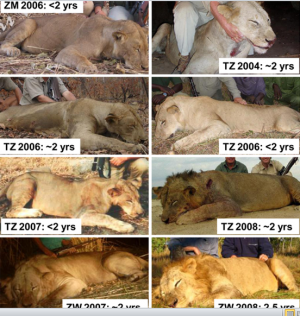News
Latest Lion Aid News
Better to over-hunt lions than not hunt them at all?
Monday 23rd January 2012
|
The success of a programme can be measured in two ways: gaining support amongst those who espouse the basic precepts, and a rush to seek compromises for those opposed. In terms of regulating lion trophy hunting, both measures apply. Since the UK Parliamentary debate on the conservation status of African lions in November 2010, LionAid has made considerable strides in alerting the public and decision-makers to both the great decline in lion numbers over the past 50 years and the additive effect that trophy hunting has made on these populations. Support is growing in Europe and among African range states to place lions on Appendix I of CITES. This move will not by itself stop trophy hunting, but will place the practice under much more careful scrutiny and impose greater limitations. Also, since import permits are required for Appendix I species, a diversity of countries are now free to make their own assessments of the trade. In addition, we expect that the IUCN will officially designate western and central African lions as “regionally endangered” in line with their small, fragmented, and declining populations (that are still trophy hunted in Cameroon, Burkina Faso, Benin, and the Central African Republic). The IUCN has been inattentive to this deserved designation, especially now that researchers at Leiden University have conclusively shown that western and central African lions are substantially genetically distinct from those in eastern and southern Africa. Suddenly, we are perhaps therefore seeing a flurry of calls to persuade that trophy hunting is of benefit to the species. For example, USA Today reported on a recent scientific article claiming that “limited lion hunting [is] better than [an] outright ban”. The article was written by Peter Lindsey, Guy Balme, Vernon Booth, and Neil Midlane. Peter Lindsey has written a number of articles on trophy hunting since 2006, all of them calling for hunters to amend their ways and make lion trophy hunting more transparent and sustainable. Lindsey always makes economic arguments, and the recent one is no different. What is different is that Lindsey now acknowledges a bit of pressure. For one, he mentions that a consortium of what he calls “animal welfare organizations” in the USA has called for a listing of lions on the USA Endangered Species Act, and also mentions that LionAid is progressing towards import bans in the EU. Lindsey et al’s arguments are based on finance rather than conservation. They threaten that by taking lions out of the equation, trophy hunting would become unviable across 59,538 km2 of currently designated hunting concessions, would result in massive expansion of “ecologically unfavourable” alternatives (livestock and agriculture), and would therefore result in greater mortality than trophy hunting. This is all supposition. Lindsey et al then predictably produce the worn-out mantra that restrictions on lion hunting “may reduce the perceived financial value of lions, encouraging increased retaliatory killings for livestock depredation”, but then come up with something equally outrageous - “…over-hunting is likely to pose little threat to the long term persistence of lions so long as interventions are made to address excessive quotas where they occur … precluding lion hunting may therefore be a greater long term risk to lions than over-hunting”. So basically, over-hunting is fine according to them; better to over-hunt than not hunt at all. Lindsey et al place too much trust in an arrogant and corrupt industry working with the support of corrupt government officials. The three major lion trophy exporting countries (excluding South Africa where there is clear evidence that captive bred lions are very significantly substituted for “wild” lion trophies) - Tanzania, Zambia, and Zimbabwe - have an average ranking of 2.7/10 on the Transparency International corruption index. Lindsey might be pushing for a kinder and gentler approach by the hunting community, but ignores the fact that such reform has hardly ever come from within the hunting industry - it has to be imposed. Lindsey should carefully read very critical reports by Nigel Leader-Williams et al (2009) about corruption and trophy hunting and one by Baldus and Cauldwell (2004) on tourist hunting in Tanzania. The latter have this to say about the reasons for conservation failures in trophy hunting concessions:
Among many other conclusions, the IUCN report mentions the following: • On average in 11 countries, 14.9% of the land area has been set aside for hunting, and the average contribution of hunting to GDP is 0.06%. This means they are the least economically productive lands in the country. Trophy hunting does therefore not represent economically valuable land use, especially in the context of the need to abate [rural] poverty and hunger.
While Lindsey et al speculatively contend that removing lions from the hunting menu would cause a collapse in the trophy hunting industry, this should not cause much concern. It is already an industry that functions only for the benefit of the operators and country elites to the disregard of communities, conservation of wildlife, and land management. That small group has until now had a monopoly on dictating how they want to (mis)utilize wildlife resources for their own benefits, but such activities no longer stand conservation scrutiny. To be effective in campaigning for the positive role of trophy hunting, Lindsey and his co-authors, as well as the Panthera Foundation (supposedly supporting the conservation of big cats worldwide, who employ Lindsey and co-author Balme, and who paid for the study) need to perhaps publish fewer vested-interest articles and actively engage in making changes to current trophy hunting malpractices. Picture credit : http://bit.ly/Ac3aJh Tags: lion trophy hunting, IUCN, western and central African lions, Categories: Trophy Hunting |
Posted by Pieter Kat at 15:23
No comments have been posted yet.
Add a new comment
Existing user
New user sign up




